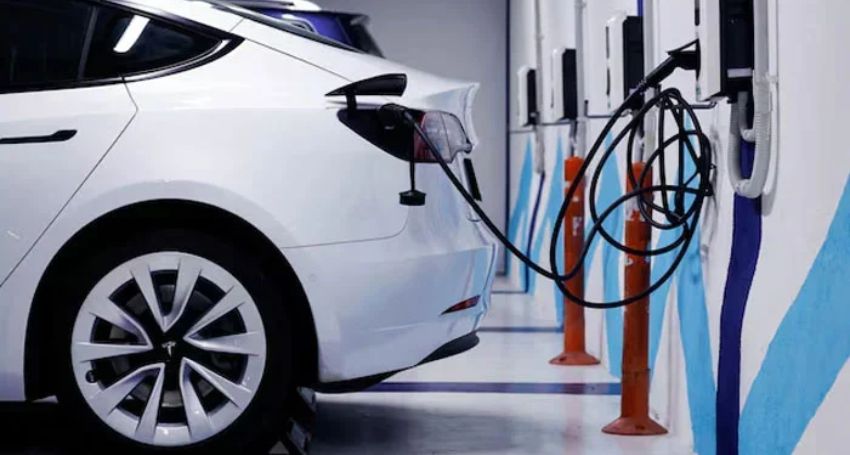
Wireless EV charging is a revolutionary technology that allows electric vehicles to charge without the need for physical cables. As EV adoption increases, wireless charging presents a hassle-free alternative to traditional plug-in methods. This article will explore how wireless EV charging works, its benefits, the underlying technology, and its future potential. With improvements in efficiency and infrastructure, wireless charging could redefine the way EVs are powered, making charging seamless and more integrated into daily life.
What Is Wireless EV Charging?
Wireless EV charging, also known as inductive charging, enables electric vehicles to charge by simply parking over a charging pad. This eliminates the need for plug-in cables and offers a more convenient way to charge an EV. The process relies on electromagnetic fields to transfer energy between a charging station and the vehicle’s battery without any physical connection.
Unlike traditional charging methods, wireless EV charging removes the dependency on cables, reducing wear and tear while enhancing user convenience. This technology is particularly useful in urban environments, where dedicated charging infrastructure may be limited or difficult to access.
How Does Wireless EV Charging Work?
Wireless EV charging operates on the principle of electromagnetic induction. A charging pad on the ground creates a magnetic field, which is picked up by a receiver unit in the vehicle. Here’s how the process works:
- Charging Pad Installation – A charging pad is installed on the ground, either in a home garage or at a public charging station. These pads contain primary coils that generate an electromagnetic field.
- Vehicle Alignment – The EV must be parked precisely over the charging pad to establish an efficient energy transfer. Many modern systems use sensors and automated parking assistance to help drivers position their vehicles correctly.
- Electromagnetic Induction – The charging pad generates an alternating electromagnetic field, which induces an electric current in the vehicle’s receiver unit. This receiver contains secondary coils that capture the energy and convert it into a usable form.
- Energy Conversion – The receiver converts the induced current into DC electricity, enabling direct DC charging of the vehicle’s battery. This process ensures seamless energy flow without the need for cables.
- Automatic Charging Process – Once the vehicle is aligned, charging begins automatically, eliminating the need for plugging in cables. The system can also communicate with the car to monitor charging levels and stop charging when the battery is full.
This process allows EV owners to charge their vehicles without manual intervention, enhancing the overall user experience and eliminating concerns about physically connecting a charger.
Technology Behind Wireless EV Charging
The core technology behind wireless EV charging includes:
- Inductive Charging – Uses two coils: one in the charging pad and one in the vehicle, creating an electromagnetic field to transfer power.
- Magnetic Resonance – Helps increase efficiency by allowing energy transfer over short distances, reducing the need for perfect alignment.
- Wireless Power Transfer – Ensures seamless energy flow without direct contact, reducing wear and tear associated with traditional cable-based charging.
- Smart Charging Systems – Many wireless charging systems integrate smart technology to optimize charging efficiency, manage energy distribution, and provide real-time feedback to EV owners.
Future advancements in this technology are expected to enhance energy efficiency and reduce the cost of implementation, making wireless EV charging more accessible to a wider audience.
Advantages of Wireless EV Charging
- Convenience – No need to handle charging cables, making the process effortless and reducing wear on charging ports.
- Safety – Reduces wear and tear on charging connectors and prevents trip hazards from exposed cables, which is especially beneficial in public areas.
- Weather Resistant – Works even in harsh weather conditions, preventing issues related to wet or frozen charging cables.
- Autonomous Vehicle Integration – Enables automated charging for self-driving cars, making it an essential technology for the future of autonomous mobility.
- Reduced Clutter – Since there are no cables involved, wireless charging stations can be more aesthetically pleasing and space-efficient.
- Lower Maintenance – Because there are no exposed electrical contacts, wireless charging systems require less maintenance compared to traditional plug-in chargers.
With these benefits, wireless charging technology has the potential to make EV ownership more user-friendly and efficient in the long run.
Challenges and Limitations
- Lower Efficiency – Wireless charging can be less efficient than wired charging, with some energy lost during the transfer process, impacting overall charging speed.
- Costly Infrastructure – Installing charging pads requires significant investment, making widespread adoption a challenge.
- Precise Parking Needed – The vehicle must be accurately aligned for optimal charging; misalignment can result in energy loss or failed charging. Advanced positioning systems are being developed to mitigate this issue.
- Limited Availability – Wireless charging technology is still in the early stages of adoption, meaning fewer charging locations compared to traditional plug-in stations.
- Slower Charging Speeds – In many cases, wireless charging is slower than wired fast-charging solutions, though improvements in technology aim to close this gap.
Despite these challenges, continued investment in research and development is expected to address these limitations, making wireless EV charging more efficient and cost-effective over time.
Read More: How Cold Weather Affects Electric Vehicles: What EV Drivers Need to Know
The Future of Wireless EV Charging
As technology advances, wireless EV charging is expected to become more efficient, affordable, and widely available. Automakers and tech companies are working on improving the efficiency and adoption of this technology. Future developments may include:
- Dynamic Wireless Charging – Charging vehicles while they are in motion using embedded road-based charging systems, allowing EVs to recharge on highways and urban roads.
- Higher Efficiency Systems – Reducing energy losses to make wireless charging as effective as wired charging, potentially achieving similar charging speeds.
- Standardization Efforts – Establishing global standards to ensure compatibility between different EV models and charging systems, making wireless charging more practical for mass adoption.
- Integration with Smart Grids – Allowing more efficient energy distribution and real-time monitoring of charging stations, reducing strain on the electrical grid.
- Greater Public Infrastructure – Expansion of wireless charging networks in urban centers, workplaces, and highways to ensure widespread accessibility.
With these advancements, wireless EV charging could soon become the norm, eliminating the need for physical charging cables and revolutionizing the way EVs are powered.
Conclusion
Wireless EV charging is an innovative solution that simplifies the charging process for electric vehicles. While there are some challenges, ongoing advancements in technology promise a future where EV charging is completely cable-free and seamlessly integrated into everyday life.
As infrastructure expands and technology improves, wireless charging could become the standard for electric vehicles worldwide, offering a smarter and more convenient way to power the future of mobility. With increasing adoption, this technology has the potential to make EV ownership even more practical and efficient, paving the way for a cleaner and more sustainable transportation system.



